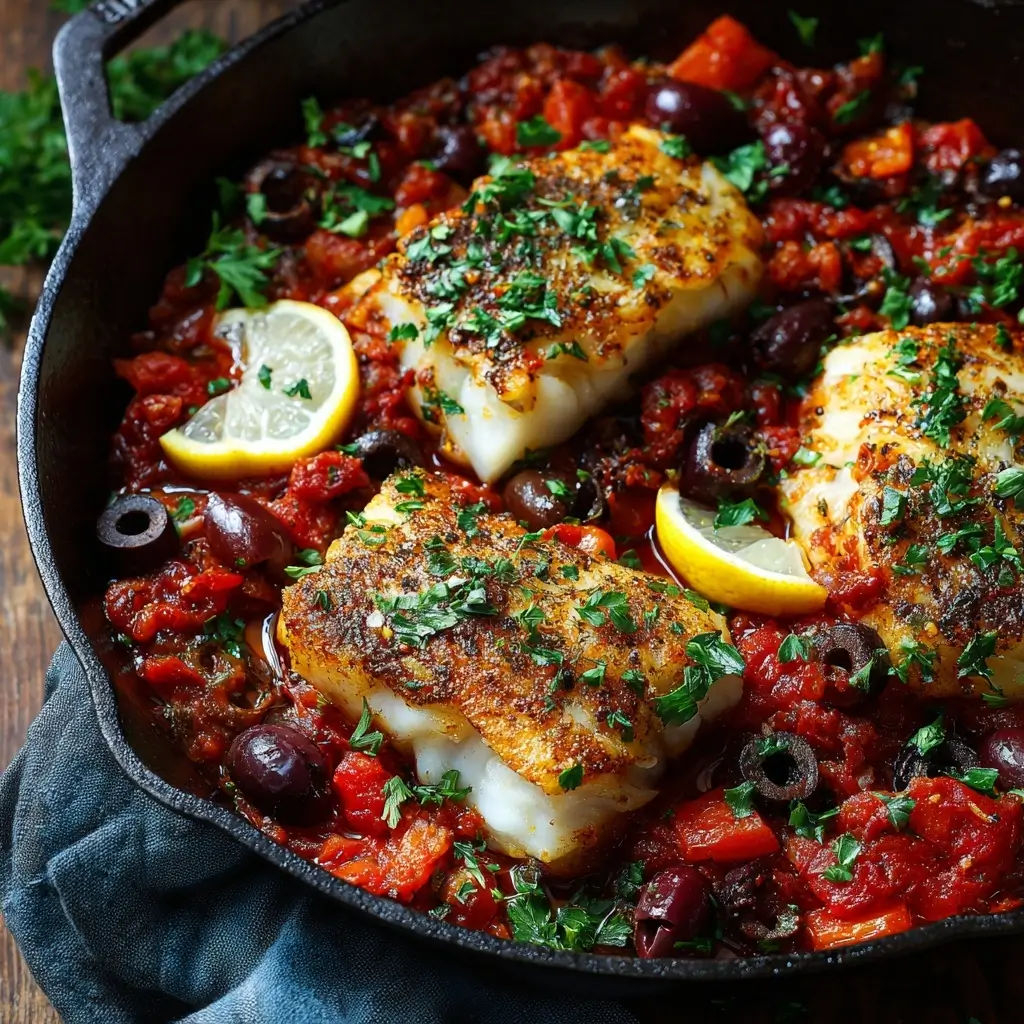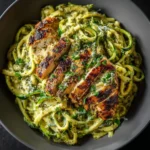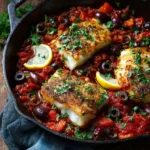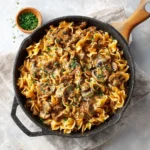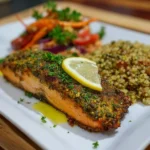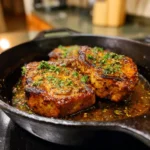Greek Baked Cod with Olive & Tomato Ragù: A Mediterranean Delight
If you’re searching for a dish that captures the essence of the Mediterranean—bright, fresh, and rich in flavor—look no further than Greek Baked Cod with Olive & Tomato Ragù. This wholesome recipe brings together tender white fish, sun-ripened tomatoes, briny Kalamata olives, and aromatic herbs to create a one-pan wonder that’s as nourishing as it is delicious. Perfect for a weeknight dinner or an elegant weekend meal, this dish embodies the heart of Greek coastal cuisine, where simplicity meets bold taste. Whether you’re a seafood lover or simply exploring healthier cooking methods, this baked cod recipe delivers on every level.
The History Behind the Dish
Greek cuisine has long celebrated the sea, with fish playing a central role in traditional meals across the Aegean islands and mainland coastal villages. Cod, though not native to the Mediterranean, has been embraced by Greek cooks due to its firm texture and mild flavor, which absorbs the vibrant ingredients of the region beautifully. The use of olive oil, tomatoes, olives, garlic, and oregano reflects the core elements of the Mediterranean diet—a culinary tradition recognized by UNESCO as an Intangible Cultural Heritage.
The concept of a tomato-based ragù in Greece differs from its Italian cousin; rather than being slow-simmered with meat, the Greek version is lighter, fresher, and often cooked quickly to preserve the integrity of seasonal produce. This particular dish draws inspiration from psari plaki, a classic Greek-style baked fish preparation where fish is topped with a savory tomato sauce and baked until flaky. Over time, home cooks began incorporating local additions like Kalamata olives and capers to deepen the umami profile, resulting in modern variations such as this Olive & Tomato Ragù.
Baking fish in parchment or en papillote is also a traditional method in Greece, allowing flavors to steam and meld while preserving moisture. Our recipe honors these techniques while streamlining them for contemporary kitchens, making it accessible without sacrificing authenticity.
Ingredients Breakdown: What Makes It Shine
The magic of this dish lies in its high-quality, minimally processed ingredients. Each component contributes to a harmonious balance of acidity, saltiness, sweetness, and herbal aroma:
- Cod Fillets: Mild, lean white fish with large flakes that hold up well during baking. Look for sustainably sourced Atlantic or Pacific cod.
- Extra Virgin Olive Oil: The cornerstone of Greek cooking. Choose a robust, fruity variety to elevate both the sauce and the fish.
- Tomatoes: Ripe plum or Roma tomatoes are ideal for their low water content and concentrated flavor. Cherry tomatoes can be used for a sweeter twist.
- Kalamata Olives: These dark purple Greek olives add a tangy, slightly fruity brininess essential to the ragù.
- Red Onion & Garlic: Provide depth and aromatic foundation. Slow-cooked gently to avoid bitterness.
- Dry White Wine: Adds complexity and helps deglaze the pan. A crisp Assyrtiko or Sauvignon Blanc works perfectly.
- Fresh Oregano & Thyme: Iconic Mediterranean herbs. Oregano offers earthy warmth, while thyme adds subtle floral notes.
- Capers: Tiny bursts of salty-tart flavor that complement the olives beautifully.
- Lemon Zest & Juice: Brightens the entire dish, cutting through richness and enhancing freshness.
- Sea Salt & Black Pepper: Enhance natural flavors without overpowering.
- Feta Cheese (optional): Adds creamy tang when crumbled on top before serving.
- Fresh Parsley: For garnish, adding color and a clean herbal finish.
Step-by-Step Recipe
Follow these detailed steps to prepare a restaurant-worthy Greek Baked Cod with Olive & Tomato Ragù right in your own kitchen.
- Preheat the Oven: Set your oven to 375°F (190°C). This moderate temperature ensures even cooking without drying out the delicate cod.
- Prepare the Tomatoes: Dice 4 medium Roma tomatoes (seeds and excess pulp removed) and place them in a mixing bowl. Add 1 finely chopped red onion, 3 minced garlic cloves, ½ cup pitted and halved Kalamata olives, 1 tablespoon drained capers, 1 teaspoon dried oregano (or 1 tbsp fresh), 1 teaspoon chopped fresh thyme, zest of 1 lemon, and juice of half a lemon.
- Create the Ragù Base: In a large oven-safe skillet or sauté pan, heat 3 tablespoons of extra virgin olive oil over medium heat. Add the prepared tomato mixture and stir to combine. Cook for 8–10 minutes, stirring occasionally, until the tomatoes begin to break down and release their juices.
- Enhance with Wine: Pour in ¼ cup dry white wine and simmer for another 3–4 minutes until the alcohol evaporates and the sauce thickens slightly. Season with sea salt and freshly ground black pepper to taste. Remove from heat.
- Season the Cod: Pat 4 cod fillets (6 oz each) dry with paper towels. Sprinkle both sides lightly with salt, pepper, and a pinch of oregano. Place the fillets directly onto the ragù in the skillet, nestling them gently into the sauce. Do not submerge completely—tops should remain exposed.
- Add Moisture & Flavor: Drizzle each fillet with ½ tablespoon olive oil and a squeeze of fresh lemon juice. Optionally, tuck thin lemon slices around and over the fish for added citrus infusion.
- Bake Until Flaky: Transfer the skillet to the preheated oven. Bake uncovered for 18–22 minutes, depending on thickness. The cod is done when it flakes easily with a fork and reaches an internal temperature of 145°F (63°C).
- Rest and Garnish: Remove from oven and let rest for 3–5 minutes. This allows the juices to redistribute. Sprinkle generously with chopped fresh parsley and, if desired, crumble feta cheese over the top.
- Serve Warm: Serve directly from the skillet for a rustic presentation. Pair with crusty whole-grain bread, couscous, quinoa, or a simple Greek salad.
Expert Tips for Success
- Choose Thick-Cut Fillets: Uniform thickness ensures even cooking. If fillets vary in size, fold thinner ends underneath to prevent overcooking.
- Don’t Overcook the Fish: Cod turns rubbery if baked too long. Keep a close eye during the last few minutes. It will continue to cook slightly after removal from the oven.
- Use Oven-Safe Cookware: Cast iron, ceramic, or stainless steel skillets work best. Avoid nonstick if possible, as high heat may degrade the coating over time.
- Boost Umami: Add a splash of fish sauce (½ tsp) or anchovy paste to the ragù for deeper savoriness without making it taste fishy.
- Acidity Balance: Taste the ragù before baking. Adjust lemon juice or a dash of red wine vinegar if needed to brighten the flavors.
- Make Ahead Option: Prepare the ragù up to one day in advance and refrigerate. Reheat gently before adding the cod and baking.
- Parchment Method: For individual portions, line baking sheets with parchment paper, divide the ragù and cod, wrap into packets, and bake at 375°F for 15–18 minutes.
Variations and Customizations
This recipe is wonderfully adaptable to different tastes, dietary needs, and ingredient availability:
- Other Fish Options: Try halibut, sea bass, haddock, or salmon. Adjust cooking times accordingly—fattier fish may need slightly less time.
- Vegan Version: Skip the fish and use thick slabs of eggplant, zucchini, or roasted cauliflower steaks. Bake until tender and golden.
- Spicy Kick: Add a pinch of red pepper flakes or a diced fresh chili to the ragù for heat.
- Herb Swaps: Replace oregano with marjoram or add a bay leaf while simmering the sauce (remove before baking).
- Citrus Twist: Substitute orange zest and juice for lemon for a sweeter, more floral note.
- Green Olive Variation: Use green Halkidiki olives instead of Kalamatas for a milder, buttery flavor.
- With Potatoes: Layer sliced Yukon Gold potatoes at the bottom of the dish before adding the ragù and fish for a complete meal.
- Creamy Finish: Stir a spoonful of Greek yogurt into the warm ragù just before serving for a richer texture.
Health Considerations and Nutritional Value
Greek Baked Cod with Olive & Tomato Ragù aligns beautifully with the principles of the Mediterranean diet—one of the most researched and recommended eating patterns for long-term health.
Nutritional Highlights (per serving, approx. 6 oz cod + ¾ cup ragù):
- Calories: ~320 kcal
- Protein: 34g – supports muscle repair and satiety
- Fat: 16g – primarily heart-healthy monounsaturated fats from olive oil
- Saturated Fat: 3g – low, contributing to cardiovascular wellness
- Carbohydrates: 9g – mostly from fiber-rich vegetables
- Fiber: 3g – aids digestion and gut health
- Sodium: ~580mg – moderate; reduce by rinsing olives and capers thoroughly
- Omega-3 Fatty Acids: Present in cod, supporting brain and heart function
- Vitamins & Minerals: Rich in vitamin D, selenium, vitamin C (from tomatoes and lemon), potassium, and antioxidants like lycopene.
Health Benefits:
- Heart Health: Olive oil and omega-3s help reduce inflammation and lower bad cholesterol (LDL).
- Weight Management: High protein and healthy fats promote fullness, reducing overeating.
- Blood Sugar Control: Low glycemic load makes this dish suitable for diabetics when portion-controlled.
- Anti-Inflammatory Effects: Tomatoes (lycopene), olives (polyphenols), and herbs contribute powerful plant compounds linked to reduced chronic disease risk.
Dietary Notes:
- Gluten-Free: Naturally gluten-free (ensure wine is certified GF if necessary).
- Dairy-Free: Omit feta for a fully dairy-free version.
- Pescatarian: Perfect fit for pescatarian diets.
- Keto-Friendly?: Slightly higher in carbs due to tomatoes; modify with fewer tomatoes and more olives/oil for a low-carb approach.
Full Ingredients List
- 4 (6 oz) skinless cod fillets, patted dry
- 3 tbsp extra virgin olive oil (plus more for drizzling)
- 4 medium Roma tomatoes, seeded and diced
- 1 small red onion, finely chopped
- 3 garlic cloves, minced
- ½ cup pitted Kalamata olives, halved
- 1 tbsp capers, drained
- ¼ cup dry white wine (e.g., Assyrtiko, Sauvignon Blanc)
- 1 tsp dried oregano (or 1 tbsp fresh)
- 1 tsp chopped fresh thyme (or ½ tsp dried)
- Zest and juice of 1 lemon (divided use)
- Sea salt and freshly ground black pepper, to taste
- Optional: ¼ cup crumbled feta cheese
- Optional: 2 thin lemon slices per fillet
- 2 tbsp chopped fresh parsley, for garnish
Detailed Directions
- Preheat Oven: Turn oven to 375°F (190°C). Position rack in the center.
- Make the Ragù: In a large oven-safe skillet, heat 3 tablespoons olive oil over medium heat. Add red onion and sauté for 3–4 minutes until softened but not browned. Stir in garlic and cook for 30 seconds until fragrant.
- Add diced tomatoes, olives, capers, oregano, thyme, lemon zest, half the lemon juice, salt, and pepper. Stir well and cook for 8–10 minutes, allowing the tomatoes to soften and release liquid.
- Pour in white wine and simmer for 3–4 minutes until reduced slightly and aromatic. Taste and adjust seasoning. Remove from heat.
- Arrange the Cod: Place cod fillets on top of the ragù, spacing evenly. Gently press down so about half the fish is surrounded by sauce.
- Drizzle each fillet with olive oil and a squeeze of remaining lemon juice. Top with lemon slices if using.
- Bake: Transfer skillet to oven. Bake for 18–22 minutes, until cod is opaque and flakes easily with a fork.
- Finish: Remove from oven. Let rest 5 minutes. Sprinkle with fresh parsley and feta (if using).
- Serve: Plate immediately with sides of choice. Spoon extra ragù over each fillet.
Frequently Asked Questions (FAQ)
Can I use frozen cod?
Yes, but thaw it completely in the refrigerator overnight. Pat very dry before using to prevent excess moisture in the dish.
Is there a substitute for white wine?
Use unsalted vegetable broth mixed with 1 tsp white wine vinegar or lemon juice to mimic acidity.
Can I grill instead of bake?
Absolutely! Grill the cod on a well-oiled griddle or in foil packets over medium heat for 6–8 minutes per side. Serve with warm ragù on top.
How do I store leftovers?
Cool completely and refrigerate in an airtight container for up to 2 days. Reheat gently in a covered skillet over low heat to prevent flaking.
Can I freeze this dish?
Freezing is not recommended for cooked cod, as the texture becomes mushy upon thawing. Freeze the ragù separately for up to 3 months.
Why did my sauce turn watery?
Tomatoes vary in juiciness. Always seed them and cook the ragù sufficiently before baking. You can strain excess liquid if needed.
What sides pair best with this dish?
Try a Greek horiatiki salad, lemon rice, roasted potatoes, grilled vegetables, or orzo pasta.
Can I make this dairy-free and still get creaminess?
Yes! Blend a few cooked beans (like cannellini) into the ragù, or swirl in a bit of tahini for richness without dairy.
Summary
Greek Baked Cod with Olive & Tomato Ragù is a celebration of Mediterranean flavors—flaky cod baked in a vibrant, herb-kissed sauce of tomatoes, olives, garlic, and lemon. Healthy, easy to prepare, and deeply satisfying, it’s a dish that nourishes both body and soul.
